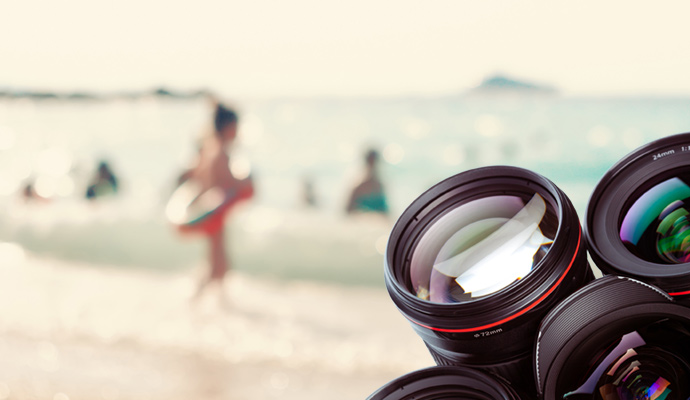
Summer is upon us, and that means lots of long, fun-filled, worry-free days ahead. If you’re anything like me, most of your favourite memories of youth revolve around the summertime. Hopefully you’re planning to have a camera handy all summer long so that you can capture those fleeting moments of joy and excitement that will pass by all too quickly.
Today I’m going to give you some advice on choosing the best lens to help you get more from your photography this summer.
Good Lenses Make Better Photos
When I first began taking photos, I had no idea about the impact of the lens on the quality of a photograph, but I now know that it has a huge influence. Good lenses have better optical components which transmit the light to the sensor with less distortion and give much better sharpness and clarity than your average kit lens (the lens that comes with your camera).
Investment
You’re probably thinking that a good lens is going to be a an expensive investment, and it’s true you can drop quite a bit of money on a high-end lens like a Canon L series lens for example, but there are also some budget friendly options out there that can give you fantastic results.
Prime Lenses
Whenever I talk to anyone who’s just bought a new Canon DSLR, I tell them about Canon’s 50mm prime lenses. Prime lenses have a fixed focal length, so you can’t zoom in and out like you can with the kit lens. The advantage of prime lenses, however, is that you get much better image quality, essentially because they contain less optical elements, so the light entering the lens is subject to less distortion.
 Build Quality
Build Quality
The Canon 50mm f/1.8 is a great lens for the casual photographer, and it’s very affordable. The build quality isn’t amazing, granted, but that trade-off helps keep the price down. If you do want something a little more sturdy for your outdoor adventures, you might like the 50mm f/1.4, which is one of my all-time favourite lenses. The difference between the two lenses is not just the build quality, but also the maximum aperture (f/1.4 versus f/1.8).
Bigger Aperture, Nicer Background
A bigger maximum aperture (which equates to a lower f number) allows more light into the camera, and so you get a little bit more low-light performance. A big aperture also gives you a very shallow depth of field (the space within which your subject is in focus) and those lovely blurred out backgrounds that portrait photographers love. Bear in mind however that sharpness tends to drop off at the bigger apertures.
Compact And Portable
The other advantage of prime lenses is that they’re smaller than zoom lenses, and I’m definitely the kind of photographer who is more likely to bring my camera if it’s compact and easy to carry.
Pancake Lens
And when it comes to compact there are few lenses that can match Canon’s 40mm f/2.8 ‘pancake’ lens. It could almost be confused for a dust cover! Pair this with the Canon SL1, the world’s smallest DSLR, and you’ve got a subtle and unassuming little setup capable of creating amazing images.
 High-End Lenses
High-End Lenses
If budget isn’t an issue for you, and you are uncompromising in your quest for the best possible image quality, then you may want to consider a lens like Canon’s EF 24-70mm f/2.8L II USM lens. This is an incredibly well-built lens, which is both dust and water resistant. It has a nice large maximum aperture, and is capable of producing amazing images either at the wide-angle 24mm focal length or zoomed in to 70mm. This is one of the reasons the 24-70 is such a popular lens amongst professionals who shoot events and weddings; it gives you lots of flexibility. A high-end lens like this will retain its resale value very well, which is an argument you may like to use when explaining to your other half what a great investment it is!
Alternative Lenses
Of course Canon isn’t the only manufacturer that offers alternative lenses to their kit lenses. Nikon makes some excellent lenses under it’s Nikkor brand, including the 50mm f/1.8G lens. Sony also makes quality lenses, like the 50mm f/1.8 SAM DT lens.
Crop Factor
Another important consideration when choosing a lens is something called the crop factor. This is a result of the variation in sensor sizes among DSLRs. There are essentially two sizes: full-frame and the smaller APS-C. The Nikon D610 has a full-frame sensor for example, while the D5300 has an APS-C sized sensor. Imagine the sensor sitting behind the circular glass elements of the lens; it only captures part of the scene that the lens sees, and the smaller the sensor, the less it captures. Hence we have a crop factor, which makes the image from a camera with a smaller sensor appear more ‘zoomed in’. For an APS-C sensor the crop factor is 1.6, and we multiply the focal length of the lens by the crop factor to get the apparent focal length. So if you mount a 50mm lens on a camera with an APS-C sensor, it behaves like a 80mm lens. This is a perfect focal length for making portraits, but it can be a bit restrictive for group shots, or if you want to capture more background and environment. So if you do own a camera with an APS-C sensor (or a DX in the Nikon world) you might want to consider a 35mm (which behaves like a 56mm) or a 24mm (which behaves like a 39mm).
Other Manufacturers
Another option is to look at a lens from a third-party manufacturer like Bower, Sigma and Tamron. These are all very reputable companies that make some fine lenses, often at prices designed to undercut the big manufacturers. Best Buy carries a host of such lenses so it’s definitely worth doing some research into those lenses that are available for your camera model.



